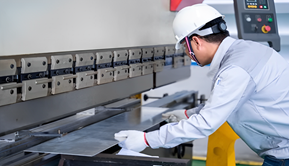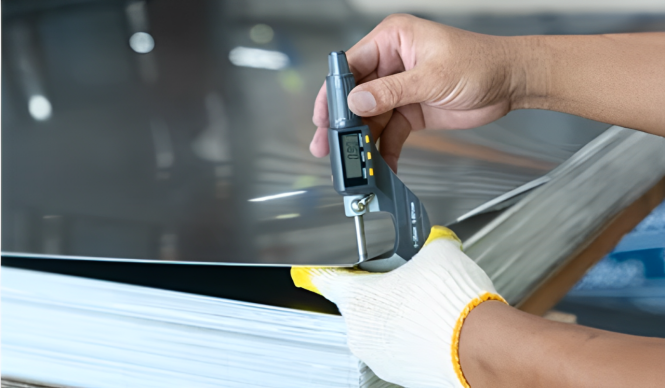Does Stainless Steel Tarnish? Understanding Its Durability and Care
Many products across diverse industries makes use of stainless steel. The key sectors include kitchen, medical, and jewelry. Your interest in stainless steel lies in its stylish design and long-lasting nature but you wonder does stainless steel tarnish? Knowing how it works and get tarnished ensures you how you maintain its high-quality performance. People think stainless steel resists all stains yet its surface reacts to specific environmental factors. This article examines stainless steel material construction alongside factors that impact its durability plus effective cleansing methods. Are you ready to discover how to maintain stainless steel at its best? Let’s explore.
Table of Contents
ToggleInsights on Stainless Steel
An alloy that features stronger toughness and corrosion resistivity. Its chromium content creates an oxide barrier that blocks rust formation. Stainless steel achieves better durability and heat tolerance through additional metals such as nickel, molybdenum, and carbon. Stainless steel proves reliable and durable so you find it used in construction materials medical tools and kitchenware.

| Sr. No. | Element | Austenitic Stainless Steel | Ferritic Stainless Steel | Martensitic Stainless Steel | Duplex Stainless Steel |
| 1 | Chromium (Cr) | 16-26% | 10.5-30% | 11.5-18% | 19-32% |
| 2 | Nickel (Ni) | 6-36% | 0-5% | 0-5% | 3.5-8% |
| 3 | Molybdenum (Mo) | 0-7% | 0-4% | 0-1% | 0.5-5% |
| 4 | Manganese (Mn) | 0-2% | 0-1% | 0-2% | 0-2% |
| 5 | Silicon (Si) | 0-1% | 0-1% | 0-1% | 0-1% |
| 6 | Carbon (C) | 0.03-0.25% | 0.02-0.08% | 0.1-1.2% | 0.02-0.03% |
| 7 | Nitrogen (N) | 0-0.5% | 0-0.05% | 0-0.05% | 0.1-0.3% |
| 8 | Phosphorus (P) | 0-0.045% | 0-0.04% | 0-0.04% | 0-0.04% |
| 9 | Sulfur (S) | 0-0.03% | 0-0.03% | 0-0.03% | 0-0.03% |
| 10 | Iron (Fe) | Balance | Balance | Balance | Balance |
Common Steel Grades and Their Characteristics
| Sr. No. | Property | Austenitic Stainless Steel | Ferritic Stainless Steel | Martensitic Stainless Steel | Duplex Stainless Steel |
| 1 | Crystal Structure | Austenitic (FCC) | Ferritic (BCC) | Martensitic (BCT) | Mixed Austenitic & Ferritic |
| 2 | Magnetic Properties | Generally Non-magnetic (in annealed condition) | Magnetic | Magnetic | Magnetic |
| 3 | Corrosion Resistance | Excellent | Good to Moderate | Moderate | Very Good to Excellent |
| 4 | Strength | Moderate | Moderate | High (can be hardened) | High |
| 5 | Ductility/Formability | Excellent | Good | Fair | Good |
| 6 | Weldability | Excellent | Good | Fair | Good |
| 7 | Hardness | Moderate | Moderate | High (can be hardened) | High |
| 8 | Cost | Higher | Lower | Moderate | Moderate to Higher |
| 9 | Typical Applications | Kitchenware, food processing equipment, chemical tanks, architectural applications | Automotive trim, appliances, hot water tanks | Cutlery, tools, surgical instruments | Chemical processing, oil & gas, marine environments |
| 10 | Examples of Grades | 304, 316, 316L, 321 | 430, 439, 444, 409 | 410, 420, 440C | 2205, 2507, 2304 |
Does Stainless Steel Tarnish?
No, it does remain free of any kind of discolorations that you experience with other metals including brass, or copper or silver. Chorimum content within the composition play a key role. Stainless steel shows signs of damage when exposed to chlorinated water in acidic solutions or salty environments. The lower chromium content indirectly contributes to quicker discoloration. Regular cleaning and protection from harsh elements keep your stainless steel shiny. Stainless steel stays strong and prevents rust while retaining its good looks when you maintain it properly.

Pros of Stainless Steel
Highly Resistant to Tarnish and Corrosion
The oxide layer is formed by chromium in stainless steel, which protects the material from damage. Steel is protected against environmental stress to maintain length of use by this protective surface layer.
Durable and Scratch-Resistant
This material remains strong under any pressure, and stainless steel tools can be used daily because they will not break or rust due to any pressure. Because it can withstand the physical impact and scratching, you can trust it for kitchen tools and heavy tools like knives.
Hypoallergenic and Skin-Friendly
It causes no skin allergy. Products are made suitable for sensitive skin types so that you can use stainless steel tools without fear of skin reaction.
Low Maintenance and Easy to Clean
Normal water and soap run items through running and keeps stainless steel parts running well. Silver works but it needs more maintenance than stainless steel, which makes them work longer.
Environmentally Friendly and Recyclable
Stainless steel is 100% recyclable. Stainless steel has non-toxic components that protect the earth and so therefore those who care about the environment should select stainless steel.
Cons of Stainless Steel
Not as Valuable as Precious Metals
Stainless steel, which is a strong material, costs less than premium metals such as gold, platinum, and silver. Since stainless steel doesn’t carry investment value, you can choose it for everyday use.
Potential for Discoloration in Harsh Conditions
Time in hot conditions and constant contact with chemical cleaners and saltwater will ultimately change your stainless steel surface appearance.
Factors That Can Cause Stainless Steel to Tarnish or Corrode
Exposure to Harsh Chemicals
Industrial cleaners containing chlorine and bleach destroy the protective chromium oxide surface. Damage to the metal surface will compromise its protection against rust and discoloration. Always use stainless steel-safe cleaners.
Saltwater and Humidity
Lower-grade stainless steel suffers rapid pitting corrosion when submerged in ocean water and high moisture levels. Sweat contact can harm jewelry by making it look less shiny. Rinse and dry stainless steel after exposure to salt or humidity.
Improper Storage and Maintenance
Stainless steel can develop discoloration when you keep it exposed to wet and dirty surroundings. Maintain your stainless steel in a clean dry place and use a cloth to wipe away any residue buildup.

Low-Quality Stainless Steel Grades
Stainless steel varieties differ from each other. Stainless steel grades with low chromium content rust faster. Choosing top-quality stainless steel helps protect it from tarnishing over time.
High Temperatures and Heat Damage
High heat over a long time weakens the protective layer on stainless steel which makes it easier for oxidation to create color changes. Protect yourself from heat sources and choose stainless steel designed to handle high temperatures.
Comparing Stainless Steel Tarnish Resistance to Other Metals
| Sr. No. | Metal | Tarnish Resistance | Maintenance Level | Common Uses |
| 1 | Stainless Steel | High | Low | Jewelry, kitchenware, surgical tools |
| 2 | Silver | Low (easily tarnishes) | High | Jewelry, cutlery |
| 3 | Gold | Very High | Low | High-end jewelry, coins |
| 4 | Brass | Low (tarnishes easily) | High | Decorative items, musical instruments |
| 5 | Titanium | Very High | Very Low | Medical implants, aerospace |
Stainless Steel – Silver
Silver develops dark surface degradation when it comes into contact with sulfur. You must polish it often to keep the metal surface shiny. Due to its resistance against corrosion and tarnish stainless steel requires minimal upkeep compared to other metals.
Stainless Steel – Brass/Bronze
Brass and bronze transform naturally into a patina that changes the metal’s color with time. The surface changes offer unique personality but they need regular care. Stainless steel does not react with air to produce a darker surface which maintains its fresh look for longer.
Stainless Steel – Gold
Gold resists dulling but remains sensitive to damage from scratches. The strength of stainless steel makes it a more reliable choice for regular use. While gold stands out with its luxurious look.
How to Prevent Stainless Steel from Tarnishing
Proper handling keeps stainless steel strong for many years to come.
Avoid Harsh Chemicals
Highly acidic substances like bleach and rough cleaning tools harm the metal’s chromium protective layer. Use gentle cleaning products and take steps to shield the item from harmful chemicals.
Rinse After Saltwater Exposure
Salt can accelerate corrosion. After contact with seawater or salty air rinse your stainless steel item with fresh water then dry it right away.
Store in Dry Conditions
High humidity promotes oxidation. Store stainless steel items in low moisture areas and pack storage spaces with silica gel packs to remove water.
Clean Regularly with Mild Soap and Water
Cleaning away dirt and oil stops the buildup that causes damage. For this purpose employ soap with water (lukewarm) and a microfiber damp cloth for drying.
Apply Protective Coatings When Using the Material in Industrial Applications
Specialized protective coatings for industrial stainless steel can boost its durability when used in difficult settings.
How to Clean and Restore Stainless Steel’s Shine – 5 Ways
Basic Cleaning Method (Soap and Water)
Every day, wash your stainless steel surfaces with mild soap and water. Wipe the steel surface with a soft cloth soaked with water following the direction of the steel. Dry up quickly to prevent damage from water, then wipe up water with clean water. Its basic cleaning method is enough to clean everyday spots and fingerprints on stainless steel surfaces.

Removing Stubborn Stains
Baking soda, however, is an effective alternative when soap and water can’t clean properly. To clean a stain, mix baking soda with water to make a paste. Use soft cloth or sponge strokes in the surface direction to clean the steel surface. Rinse thoroughly and dry. Baking soda is used to scrub grease spots and minor discoloration on steel surfaces without hurting the surface.

Using Vinegar for Cleaning
Metal surfaces with a shiny look are achieved with white vinegar and dirt buildup takes away. For another 2 to 3 minutes put pure vinegar on the surface. It naturally breaks down stains and hard water deposits, and it is safe for steel surfaces. For a surface shine add a few drops of mineral or olive oil.

Microfiber Cloth for Daily Maintenance
To keep your stainless steel looking good, clean it with a soft microfiber cloth regularly. With no chemicals, it can eliminate fingerprints and lint from metal surfaces. Wipe in the direction of the metal grain lines to keep the natural surface texture intact. Extra shine is just a dampened microfiber cloth with water or mild cleaner.

Polishing Stainless Steel Jewelry
Maintaining your jewelry to protect it from dullness deserves special attention. In case you could afford it, use specific stainless steel cleaners or use mild soap water to wash your jewelry. Then, let your item sit in liquid for few minutes before you brush it carefully with soft bristles. Clean the surface with a microfiber cloth then wipe dry. To finish off with, a light coating of baby oil or stainless steel polish gives you extra shine on your product.

Myths and Misconceptions About Stainless Steel Tarnishing
Here, we need to bust some common myths.
Myth 1: “Stainless steel never corrodes or stains.”
Truth: Although stainless steel won’t rust or stain, it’s not indestructible. Harsh chemicals, extreme conditions, or poor maintenance can weaken its protective chromium layer over time. Stainless steel can tarnish or even corrode if not properly cared for.
Myth 2: “High grade stainless steel is just as good as low cost stainless steel.”
Truth: Not all stainless steel is the same. Stainless steel is high grade when they contain more chromium and nickel, which makes them better able to resist corrosion. Often, these elements are not present in cheaper alternatives, which makes them more susceptible to tarnishing and wear over time.
Myth 3: “In fact, all stainless steel jewelry is hypoallergenic.”
Truth: There are many types but while some are hypoallergenic, stainless steel alloys may contain nickel. Low quality stainless steel can cause allergic reactions if you have sensitive skin. Always check composition before purchasing jewelry.
Conclusion
Now you have an answer to “Does stainless steel tarnish?” It has a long life, provided it’s properly stored and cleaned regularly. For the best results, refrain from prolonged exposure to moisture and harsh chemicals. By investing in high quality stainless steel, you get low maintenance, long lasting products. Stainless steel is excellent corrosion resistant in jewelry, kitchenware, or tools. With a little bit of care, it can stay looking perfect for years. Stainless steel is your reliable, stylish choice to choose from that holds up to time.
FAQs
Can Stainless Steel Turn Black or Green?
Stainless steel is not naturally black or green. However, surface discoloration may occur due to exposure to extreme chemicals, chlorine, or oxidation. It keeps its original shine through regular cleaning.
Is Stainless Steel Waterproof?
Yes, stainless steel is waterproof. But its protective layer thins over time if it is exposed to chlorinated or salty water for too long. After water exposure, prevent damage by rinsing and drying.
Does Stainless Steel Scratch Easily?
Stainless steel is scratch resistant, but not scratch proof. Minor scratches may occur from regular wear and contact with hard surfaces. Polishing cloth can reduce surface marks.
Does Stainless Steel Jewelry Tarnish?
Stainless steel jewelry does not tarnish under normal conditions. A long lasting choice due to its chromium layer protecting it from oxidation.
Does Gold Stainless Steel Tarnish?
Over time, gold plated stainless steel can discolor due to exposure to sweat, chemicals and moisture. Its shine is maintained with proper care and storage.
Does 316L Stainless Steel Tarnish?
Yes, 316L stainless steel has improved corrosion resistance because of its molybdenum content. In harsh environments, the material remains tarnish free.
Do Stainless Steel Rings Tarnish?
Stainless steel rings don’t tarnish very easily. But they can be affected over time by contact with harsh chemicals or extreme conditions. They stay looking new through regular cleaning.
Does stainless steel tarnish in water?
While stainless steel is known for its corrosion resistance, it can tarnish or rust under certain conditions, Such as saltwater or water with harsh chemicals like chlorine. In freshwater, high-quality grades like 304 or 316 stainless steel generally do not tarnish.
Does Stainless Steel Tarnish by Saltwater and Humidity?
Lower-grade stainless steel suffers rapid pitting corrosion when submerged in ocean water and high moisture levels. Sweat contact can harm jewelry by making it look less shiny. Rinse and dry stainless steel after exposure to salt or humidity.



